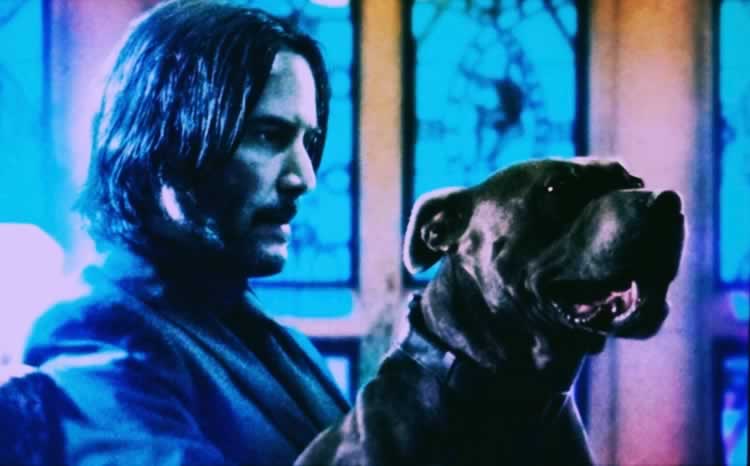
BRAND MYSTICISM IN CINEMATIC STORYTELLING:
working in the motion picture industry,
you see patterning.
Imagery above from LionsGate|Summit
There are arcs of narrative lines, plot structures—character intercessions, ascensions and descensions of protagonist figures, as well as antagonists—in their journeys, wide and far, deep and down, uplifted and upward bound.
Stories have patterns that can arise from ancient legacies
that are thousands of years old.
The Hero of One Thousand Faces—
the story from now,
the story from 5000 years ago.
This idea of deeper storylines, ancient narratives retold, can resonate with the experiencer—“somehow, I know this story from before—there’s something familiar, I can relate to this in my own experience, my life, my journey—coming from where I was, to where I am now.” It’s more than the journey, it’s the meaning of the journey, the intentionality of it: “why are you going there?”
Thinking this through in the context of brand strategy, design, anthropology, the construct of analysis weaves in meaning, visualization, styling character, colors, the patterns of graphics: the holism of experience strategy. You could think, as a designer, “evolving this brand—it’s a modern story, but it’s an ancient narrative retold—design in that thinking, drama, color, typographical styling, imagery.”
A brand needs meaning.
A brand needs to appear relevant to personal impression and magnetism: key is captivation!
Style needs synthesis—it syncs the meaning and impression.
Color and graphics—“they feel right,” they’re contextually on target.
Messaging is demographically synced. Soul+substance>audience.
Working on film-related design, it’s about all of these concerns, but it’s also deeper—is there a story inside the story, one which might reach to mythic dimensions?
And how does one design [and build messaging and imagery] around that telling?
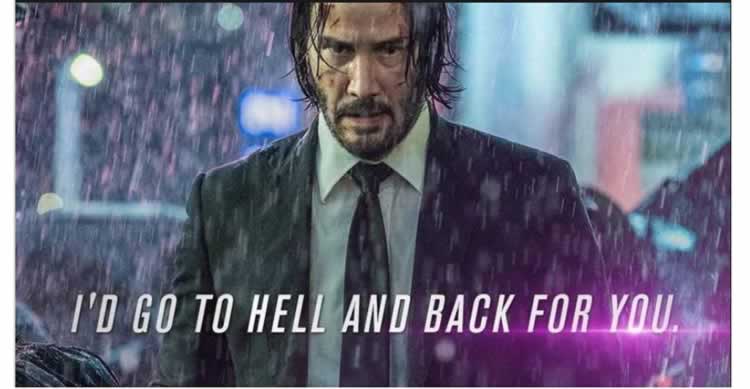
Imagery above from LionsGate|Summit
This is about that query—is there more to the story—
and the production of a film, like a brand—
it’s legendary storytelling,
and it could be mythic.
An analysis of the how of its telling could support that answer—there is an intertwined patterning of all of these elements, including the possibly mythic underpinnings of how the story is framed and portrayed.
It’s been pointed out [by us] that some storytelling in cinematic production could conceivably be seen as “monomythic,” that is: “there is a story framing, a metaphorical or allegorical way of thinking, about the deeper layering in the story—it’s the myth that eternally returns: it keeps coming back, it’s undying as a narrative pattern. If you’re a brand strategist, marketer, designer, you should be looking further than mere promissory missions, farther visioning and core KPIs—”what’s the story here and why should I, or anyone, care?”
This telling, John Wick’s story, evokes a narrative mannerism that is a repetition from countless other patternings: the story that is the same story from 1000s of years past, which are layered, legendary and mythic tellings that move from millennia to millennia. And they come back, they repeat: arriving as new entertainments in the present era.
HERO ARCHETYPE
It can resonate because we can relate—we can tell that story, as in a recanting of that selfsame story. Each of us has a powerful and unforgettably transformative journey: “I was in one place—my previous world—I was forced to come out, into a new world, I had an adventure, I had risk, I lost things and I gained things, I had powerful encounters—and I was changed. I never went back to the way that I was.”
That story is a archetypical, mythic patterning, with cultural variations, world wide.
And that could be your story. Could be a brand story. Could be a brand-founder’s telling.
You: the hero[ine].
This has a brand and design character that interweaves core business values of community connectivity: these are the R’s as we call them—
relevance, resonance, relationship
=
which is: usefulness, sounds right, I can relate.
Yes, the relating:“let me tell you a story.”
These powerful [and yet simple stories]—we like how they sound, they’re familiar for us, they resonate as we experience them since we’ve heard them be fore.
We’ve been walking this deeper pathway for decades, which began with earlier personal correspondences with the global mythologist Joseph Campbell, as well as patterns in comparative spirituality, Mircea Eliade on his personal journey of adventure and scholarship, and how that played out to his theories of patterning: bridging: language, the alphabet, calligraphic mysticism, mythology and design concretizes this layering for me.
Who else relied on Joseph Campbell’s theories on the Hero of 1000 Faces?
George Lucas.
Patterning for us, as designers, brand strategists, sales theorists and marketing practitioners lies in the realm of the play of deep space—deeper psychical meanings and relevance to brands and how they work for us.
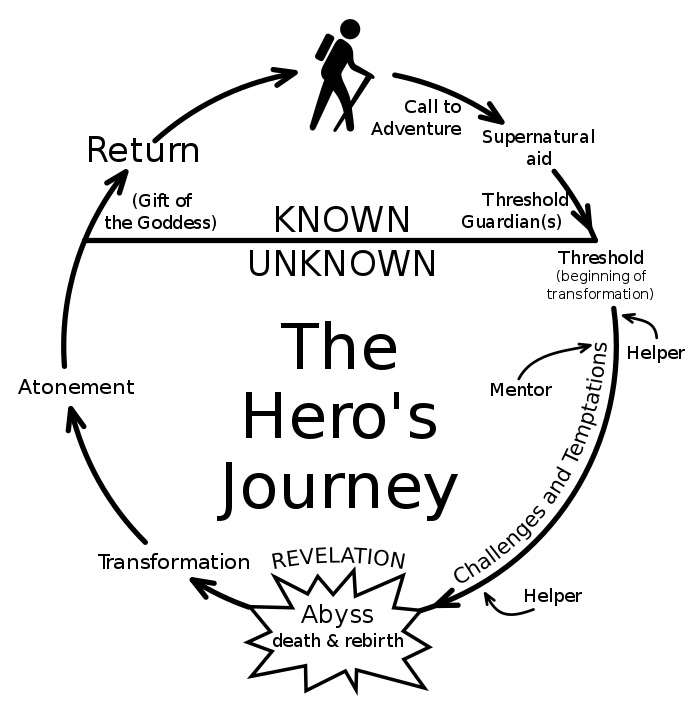
That pattern could be: in the structure of a story, a pattern of how people come into the grasping of a brand—the patterning of community and demography: the clustering of people, their interests, their persona, the patterning of how people use brands, explore movements to find brands in stores, the patterning of graphics on a display, in a store and packaging. So our thinking on patterning applies, in our world, to everything.
There is the story that the reader knows on the surface and there are others, beneath, which might be deeper and hidden from cursory view.
The mythic scholar of pattern, Mircea Eliade comments on this in a
mystically-inclined envisioning of the journey—this “brand mythology” I’m referencing—it’s about a marketing communication proposition,
it’s about your life:
“you’re out there for a reason.
You’re not just going someplace:”
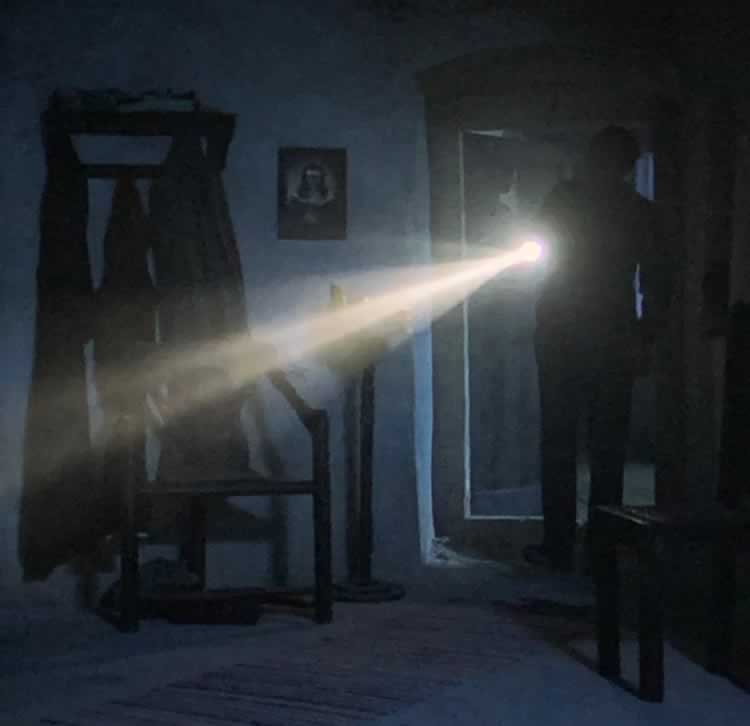
You could be looking for something in the dark.
“In each case we are confronted by the same mysterious act—the manifestation of something of a wholly different order, a reality that does not belong to our world, in objects that are an integral part of our natural “profane” world.” Mircea Eliade The Sacred and the Profane : The Nature of Religion: The Significance of Religious Myth, Symbolism, and Ritual within Life and Culture (1961), translated from the French by William R. Trask, [Das Heilige und das Profane (1957)]
These comments persist in his personal journals—“you venture out, you travel towards a quest, you go to places that you’ve never been—there is risk in this adventure. And you will be changed—in fact, you might not come back.” Eliade writes—of his own exploratory journeying, “These thirty years, and more, that I’ve spent among exotic, barbaric, indomitable gods and goddesses, nourished on myths, obsessed by symbols, nursed and bewitched by so many images which have come down to me from those submerged worlds, today seem to me to be the stages of a long initiation. Each one of these divine figures, each of these myths or symbols, is connected to a danger that was confronted and overcome. How many times I was almost lost, gone astray in this labyrinth where I risked being killed… These were not only bits of knowledge acquired slowly and leisurely in books, but so many encounters, confrontations, and temptations. I realize perfectly well now all the dangers I skirted during this long quest, and, in the first place, the risk of forgetting that I had a goal…
that I wanted to reach a “center.”
Mircea Eliade, Journal entry
(10 November 1959) published in
No Souvenirs(1977) , 74-5. Journal II, 1957-1969 (1989).
But he makes his own observation on his own life, the how of what he’s explored—his personal journey of the labyrinth: this deeper storytelling comes back to film: in that journeying which is a visualization, experience and place-making, costumery, all funneling towards a tautly managed choreography of narrative, storyweaving ancient lines of retelling.
Speaking with directors and film production teams—talking design and “what is this film about, what’s the story?” The subject ranges from raw propositions of adventuresome, excursionist storytelling to deeper patterning of archetypal layerings of context and construct in narrative.
There’s a simple story.
There’s a deep story.
What does that
mean?
THE PATTERNING OF THE HERO OF ONE THOUSAND FACES
I didn’t work on John Wick—but studying the string of stories that have emerged in Wick—I, II, III—I see some returning narratives of mythic storytelling. I go back to other GIRVIN branding propositions on mythic storytelling—
designing around archetypal heroes. The dark journey of Beowulf, the transformational journeys of Cold Mountain, the Missions: Impossible.
There are other examples of mythic storytelling—Clint Eastwood, a cyclic hero-figure unto himself and a GIRVIN client, working with him on “Unforgiven” was—his take—about the fallen Hero’s quest for redemption.
As a designer, is there a deeper story? When asked to start on the design of that filmic reference—the logo—we talked: “what’s this story about, for you?” Clint “this is a story about an ordinary man, a very hard man—a cruel man that has lived a life of cruelty. He is a man that comes out of a dark place into a journey of ‘trying to do something right’ in the world, to redeem himself. And enter a new and risk-filled world from the sanctum of his home world, his family, his remote farm. He has to come out—from this safe place to a place of danger where he will risk everything in a principle of trying to right his world—and the harrowing requests of others. Prostitutes wronged—which, in ancient storytelling—are more like creatures of a mystical divinity. He must redeem their wrong to collect a reward—at great sacrifice—in a trial to return to his “ordinary world.”
That is the hero’s journey.
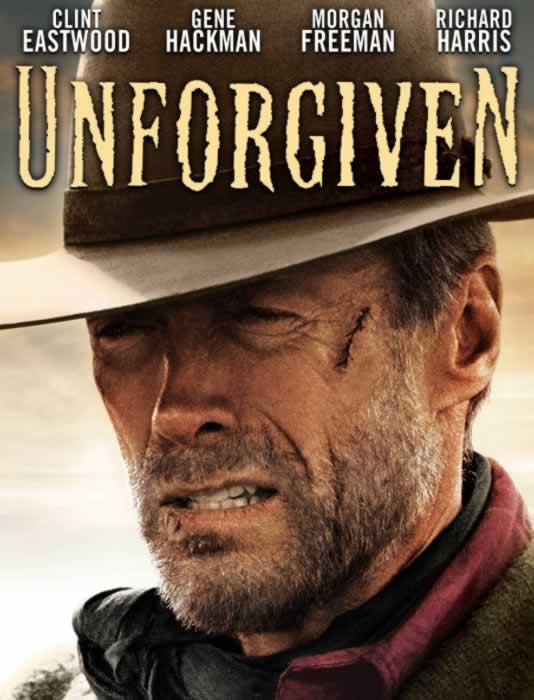
Imagery above from Warner Brothers
That journey—down a darker path—a revenge of transgression to a core symbol of ancient cultic femininity—and allegorical mystery—which, in an ancient telling, goes back to the mother goddess, as in this representation of Inanna / Ishtar — Akkadian, 2350-2150 BC.
His journey takes him tangling with combatants—other journeyers, even to the edge of death, he finds his way forward, out of the dark, into the light, back into the dark—he is a changed man—the symbolist threading of the storytelling suggests thema that reach back in time, entwined with the deep
labyrinth of human consciousness
and bicameral awareness.
So too Mr. Wick.
So too Pale Rider, Luke Skywalker, Neo—The Matrix, dozens of other tellings.
The point is that the patterning of one ancient story, deep in the mind of humankind, that repeats and announces itself—a clarion call that returns as an exultation of journeying in patterned state of experiential wisdom.
Go to the desert to give everything up,
and learn the answers of a lifetime.
And he does.
The question.
The answer.
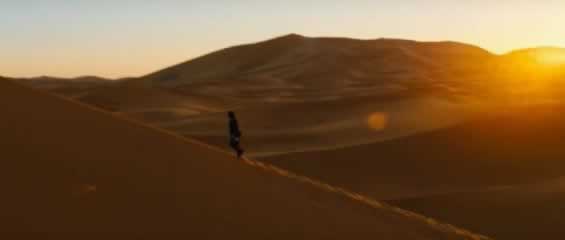
Wick’s journey has already been commented on as an archetypal manifestation—here, his path is one of dark engagement, as assassin—a taker of lives; and to this he must “exit” his ordinary world and return to a darker world,
fraught with danger to face the most unbelievable challenge
of his entire life—he must ask for help, he needs “coins” to make passage [an allusion to the gates of death—the last journey of the soul is a gateway guarded by dogs [Cerberus] and the Death Oarsman, Charon– is “the ferryman who, after receiving a soul from Hermes, would guide them across the rivers Styx or Acheron to the underworld. At funerals, the deceased traditionally had a coin placed over their eye or under their tongue, so they could pay Charon to take them across.”
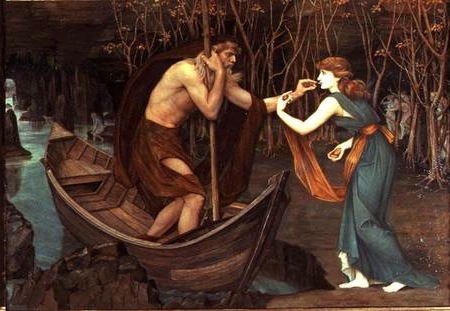
Charon—the gatekeeper of the last crossing and channel guide to hell—with Psyche in
a pre-Raphælite interpretation of the myth.
J.R.Spencer Stanhope [1883]
And to this special club—“The Continental,”
who would have the power to grant access?
The calm Concierge,
his name—
Charon.
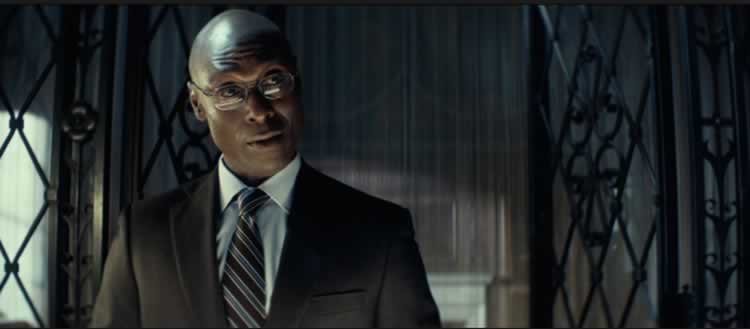
Imagery above from LionsGate|Summit
The Hero of A Thousand Faces suggests a structure which is mirrored in Wick—all three narratives play to a telling of ignition, inspiration, instigation, journey and transformation—from the ordinary, to the extraordinary, and back again. Mythologist Joseph Campbell’s theories could be summarized as:
The journey of the Hero of 1000 Faces
“The hero’s journey”
begins in the ordinary world.

He must depart from the ordinary world, when he receives a call to adventure. With the help of a mentor, the hero will cross a guarded threshold, leading him to a supernatural world, where familiar laws and order do not apply. There, the hero will embark on a road of trials, where he is tested along the way. The archetypal hero is sometimes assisted by allies. As the hero faces the ordeal, he encounters the greatest challenge of the journey. Upon rising to the challenge, the hero will receive a reward, or boon. Campbell’s theory of the monomyth continues with the inclusion of a metaphorical death and resurrection. The hero must then decide to return with this gift to the ordinary world. The hero then faces more trials on the road back. Upon the hero’s return, the gift may be used to improve the hero’s ordinary world,
in what Campbell calls,‘the application of the boon.’”
And what of Hell, that portal—that is surely part of an journey?
Could that be the Director,
Chad Staheleski and Keanu Reeves’s
gesture to Hades—Winston, club maitre’d
upholder of the law of assassins—
death dealers and the
Club Continental?
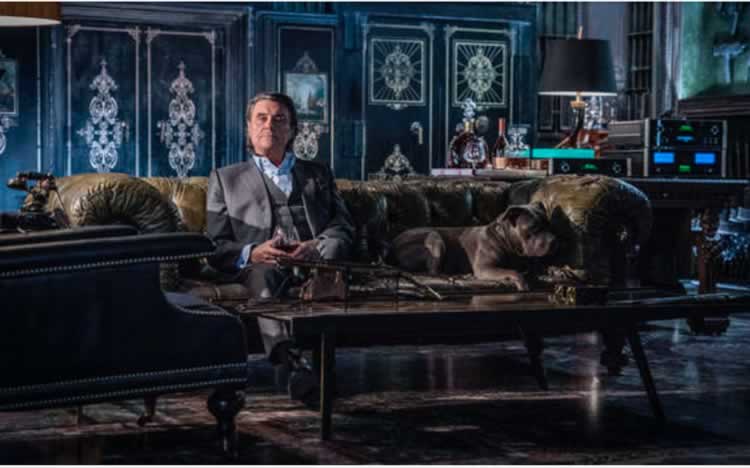
Imagery above from LionsGate|Summit
And in all this mythic inter-tangling,
there are guardian dogs and horses as well,
key myth-binding partners in many of
the journeys of a hero of a thousand faces.
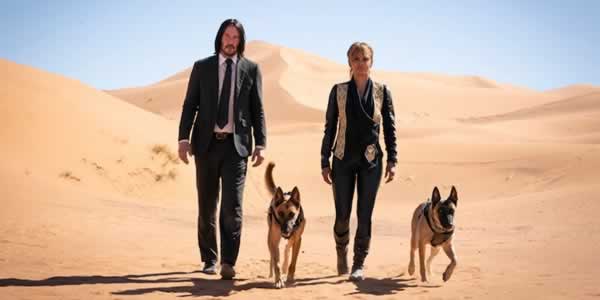
Imagery above from LionsGate|Summit
There is the surface, there is what lies beneath.
There is a story. And there is a story in a story.
Designers, strategists, brand story-builders—there are solutions that are obvious and there are answers that lie, perpetually, running as a current in a hidden river. They’re always there.
Look deep.
Go deeper.
T I M
…..
G I R V I N / DESIGNING MOVIES
THEATRICAL BRANDING + ENTERTAINMENT
IMAGINATION: AND THE TOOLS TO MAKE IT HAPPEN
The Scream Online
Movie Storytelling design: goo.gl/XCBQps
